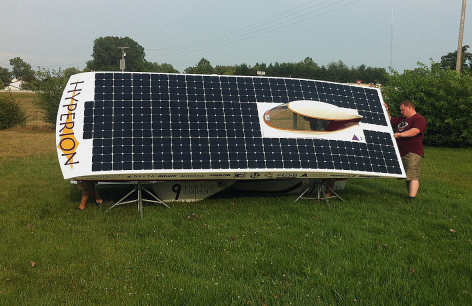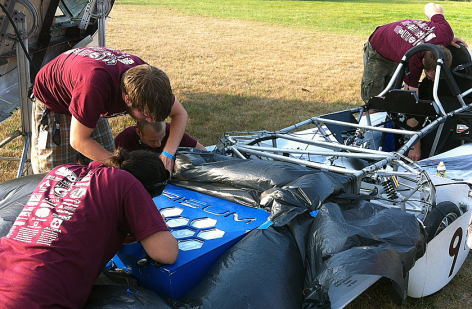
Hyperion's solar array is tilted to the sun for a better battery charge. Larger photo. Photo by Team PrISUm.
AMES, Iowa – Nearly 200 miles in stifling heat wasn’t a problem for Iowa State University’s solar race car on Wednesday.
But that wasn’t the case for most of the 11 cars competing in this year’s American Solar Challenge, an eight-day, 1,650-mile race for student-designed and student-built solar race cars.
Six of the teams had enough problems on the road they had to load their cars into trailers and haul them to the stage stop in Normal, Ill. But Hyperion, Iowa State’s solar car, cruised right in and jumped from third to second place on the scoreboard.
Evan Stumpges, Team PrISUm’s project director and a May graduate in mechanical engineering, noted that one of Hyperion’s dashboard sensors recorded a temperature of 125 degrees. But that still wasn’t enough to overheat the car’s battery pack.
“I think a lot of teams have been struggling with the heat,” Stumpges said. “It was quite warm, but our batteries are not having any problems.”
For one thing, Stumpges said, the team built a pack with batteries designed to work at higher temperatures. He also said the team’s new pack construction provides extra space between each of the 216 batteries. There are also fans blowing air through the battery pack.
The reliability of that battery pack has done a lot to help Team PrISUm overcome a rainy day accident earlier in the race.
All in all, Stumpges said, “We’re quite happy with our performance.”
On Thursday, the solar cars will race to a checkpoint in Verona, Wis. And Team PrISUm will hope for another smooth and (relatively) cool day on the road.

It takes a lot of teamwork to keep Hyperion up to speed. Larger photo. Photo by Team PrISUm.
